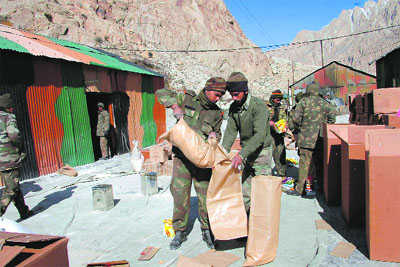Siachen can only be lived to be understood. The “hellish” conditions a soldier has to go through can never be appreciated by a politician or a babu sitting in the cosy environment of their offices. Mere sustenance of forces in this non-polar region battlefield poses unique challenges.

The responsibility of making Siachen a history lies with the BJP Government at the Centre. It must arrive at a sensible solution at the earliest. Tribune photo: Manoj Mahajan
WHEN Pandit Nehru made the historic but infamous statement about Chushul in 1964, “Not even a blade of grass grows,” it agitated the consciousness of an average Indian. He couldn’t have imagined that 20 years later Pakistani soldiers would occupy Indian territory in a glacier named Siachen, making it the world’s highest and the coldest desert battlefield where temperatures plummet to minus 50 degrees. Siachen is also the most treacherous and most expensive in terms of lives of Indian (and Pakistani) soldiers lost, without considering the huge financial burden both neighbours have to bear at the cost of feeding their poor. India has lost almost 1,000 soldiers to the inhospitable battleground without fighting any pitched battle and many more have been disabled. The recent loss of 10 soldiers of Madras Regiment, has once again brought the focus on Siachen. Pakistan too has suffered many causalities. It lost 140 soldiers in 2012 to an avalanche which swept away the entire military camp. It is surprising that considering the extreme hardships faced by troops deployed by both adversaries, regular frost-bite and snow-blindness causalities, human loss and colossal wastage of financial resources in maintaining the forces, both sides have yet to find a solution to this mad war in the past 32 years. Troops of both the countries continue to suffer in inhuman conditions, losing limbs and eyes every day, while politicians look for their own face-saving methods. Mere sustenance of forces in this non-polar region battlefield poses unique challenges. Siachen can only be lived to be understood, the “hellish” conditions a soldier has to go through can never be appreciated by a politician or a babu sitting in the cosy environment of Delhi offices. They can never understand what a soldier goes through when they visit troops for 15 minutes, wearing snow- clothing, have hot tea with pakoras and go through the ritual of a photo-shoot of their sojourn — before taking the special/earliest flight back. There is a need to go in to the genesis of the problem to find a solution rather than look for “quick-fixes”. The whole issue came to light after the American and Chinese mountaineering expeditions, attracted by the challenge of the virgin Himalayan peaks started visiting the area. India, as a policy refused permission to foreign expeditions. However, Pakistan not only encouraged them but also provided logistic support and even sponsored some of them. Having been armed with enough data on terrain and topography, Pakistan declared the glacier as their own territory. It is unfortunate that India took some time to react to the unholy design but fortunately, it was not too late and we responded in a more-than-befitting manner. The area, which has gained notoriety as Siachen remained undemarcated as no troops had been deployed there. However, on April 13, 1984, a Company of 4 Kumaon was moved by the Indian Army to counter the evil designs of Pakistan which had occupied strategic heights and Operation Meghdoot was born. Since then all efforts have been made by India to settle the dispute, then Prime Minister Manmohan Singh who visited the glacier in 2005, even talked of making it “a mountain of peace”. Several rounds of bilateral talks to settle the issue once for all have been stalled by Pakistan on one ground or the other. Both nations fully understand that continuation of deadlock or stalemate is not in the interest of either of the countries, since neither side can dislodge the other militarily in the prevailing situation.Perhaps, the best time to settle the Siachen dispute is now. Given the equation our Prime Minister has with Pakistan premier Nawaz Sharif and the rapport enjoyed by our NSA Ajit Doval and other functionaries with their Pakistani counterparts, the common man in both the countries sees a ray of hope. Of course, we have to tread very carefully in the backdrop of our adversary’s past history of mistrust and stabbing in the back every time a genuine effort was made to sort out any issue. It has been seen that every significant breakthrough in any status-quo situation is possible only when the sides involved first break with tradition, with old ways of thinking, with old paradigms.A positive shift in the mindset of both the nations is the need of the hour. India and Pakistan both have yet to experience the rewards of being truly free. Both are suffering from poverty, disease, oppression and inequality. Can they afford to continue a senseless enmity when they need resources for improving the plight of their teeming millions? The intelligentsia, the media and ordinary citizens of both the countries must pressurise the decision-makers to come to a sensible solution at the earliest. The responsibility of making Siachen a history lies with the BJP Government at the Centre; it is one of their best chances.The writer, a veteran, commanded an EME batallion at Leh and spent 10 days at Base camp.
